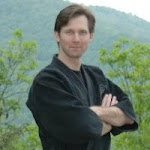The TAI systems of martial arts are all based upon the concept of allowing for personal freedom in application. The stated idea is to draw from several different styles of Martial Art to blend in a fashion that is appropriate to fit any given situation. Thereby giving the practitioner complete freedom of technique. With this said, there are a few underlying principles to help you get started on working towards this freedom.
The first step is to have a base style in which you are proficient. You have to have a foundation in something. This is a lot like a good jazz musician. The best ones are very well versed in classical music, thereby allowing them to deviate from it. At my school our base is TAI-Kenpo, but it really doesn’t matter what your base style is- just that you have one and know it well.
Once you have a good foundation, the next thing to do is start to look at the techniques as they are classically taught with the idea of finding out what the style is good at and what it does not address. You will find that to do this you will have to start looking at the techniques of other styles of Martial Art. There are two common errors with this step. First, don’t be so arrogant as to think that you are already doing the ultimate art. All of them have things that they specialize in. Second, don’t make the mistake of only looking for applications within your art. This won’t work because, for example, an art that is really good at kicking generally will not be so good at take downs. To train for take downs you would have to observe and if you can study with somebody who is good at the timing of take downs. The kicking guys- though they may see and understand the technique- won’t have the timing down so the defenses that they train will be off simply due to timing.
The way to address this is to cross train when you can, watch videos of other arts, and attend seminars. Do this with two things in mind. First, how would your art deal with a particular attack and second, how would you benefit from stealing a technique or concept from another style in an area that your base art isn’t so strong.
Next, you have to look at where the spots are that you can blend from one art to the next. In TAI we call these transition points. The best way to begin with this is to use two general concepts. First, use the concept of sentence structure from Kenpo. This means that your base technique is the noun, something in front of it is a prefix, after the noun is a suffix, and you can also add in a general array of ifs, ands, withs, etc. Look for how you can take your initial technique and then add things into it. The second thing to consider with this concept is the pattern, beat, or rhythm of the technique. In TAI we call these codes. Once you have figured out the sentence and the code for your base technique (noun) you can start to add on other stuff.
A good TAI technique should include five things: a defensive movement, and offensive movement, a lock, a takedown, and then a finish. Try to use five different arts within this sequence while using sentence structure and coding.
Finally, let’s look at how to smooth over the transition. What makes a technique a TAI technique is that this blending takes place seamlessly, meaning that the average viewer would not know that you are blending arts. To do this you have to position yourself so that the next technique is already set up, without altering the initial technique. To do this you have to plan a few steps ahead in your choreography. Let’s say that you have checked a punch with your left hand to counter punch with your right hand. What if your left hand just didn’t let go of the check, thereby setting up a transition into a wrist lock? The next step is to do the check, wrist lock, and punch all at the same time. This is TAI.
This is the beginning of how to choreograph techniques. By going through this process you will soon discover that it no longer matters which arts you say you are using. This study will allow you to achieve complete technical freedom as it teaches you how to break away from pre-choreographed routines.
 This year we had yet another successful seminar with Grand Master George Xu. This year GM Xu focused on the arts of Chen Style Tai Chi and 10 Animal Hsin Yi while focusing on the following principles:
This year we had yet another successful seminar with Grand Master George Xu. This year GM Xu focused on the arts of Chen Style Tai Chi and 10 Animal Hsin Yi while focusing on the following principles: But that wasn't all! In the week prior to the seminar Vincent Lynch of One Hand Video and China's Living Treasures came to our facility to film Grand Master Yu Xiao Lin performing the lost art of Yang Ban Hou Tai Chi. This was a special treat this art is the missing link between Chen and Yang Style Tai Chi.
But that wasn't all! In the week prior to the seminar Vincent Lynch of One Hand Video and China's Living Treasures came to our facility to film Grand Master Yu Xiao Lin performing the lost art of Yang Ban Hou Tai Chi. This was a special treat this art is the missing link between Chen and Yang Style Tai Chi.

